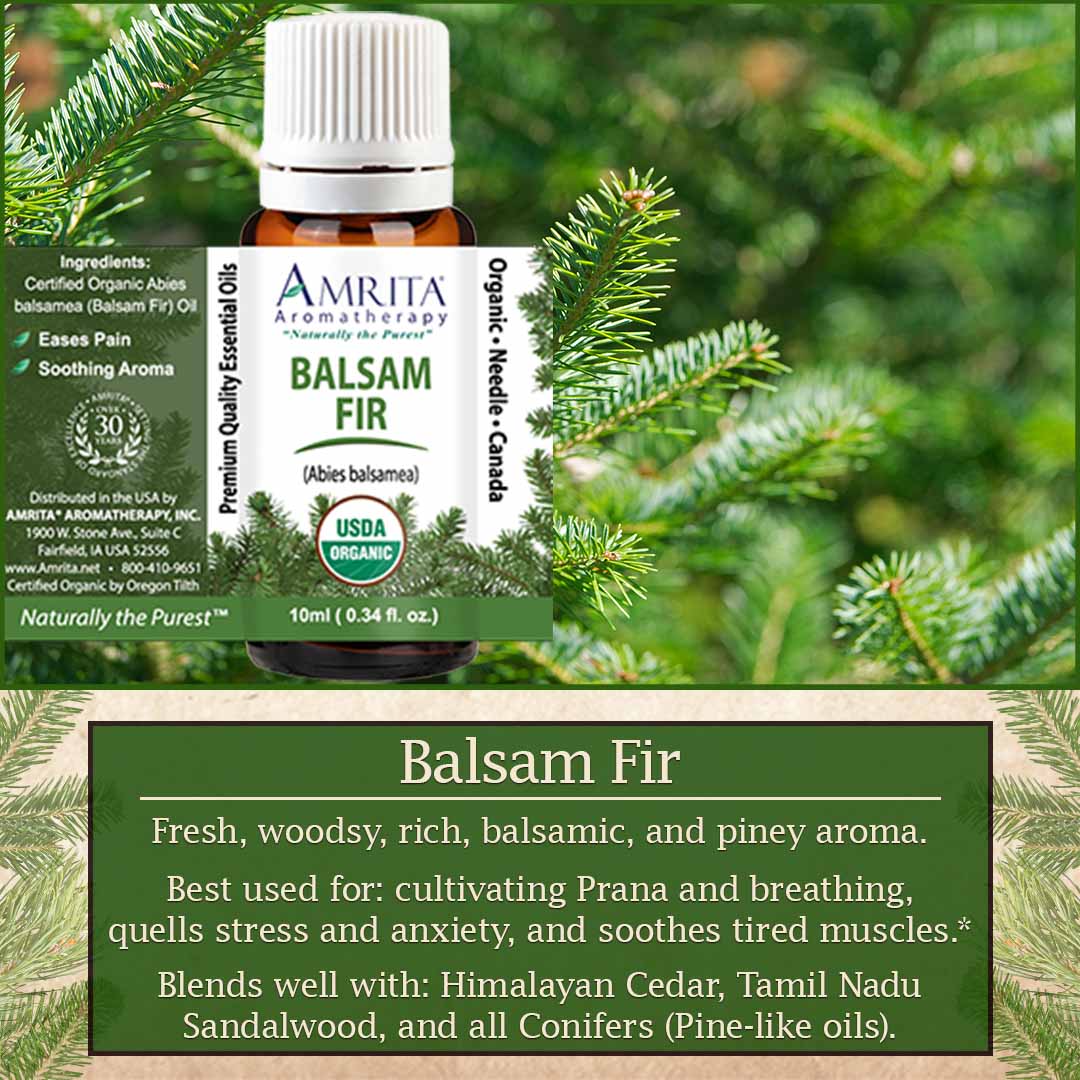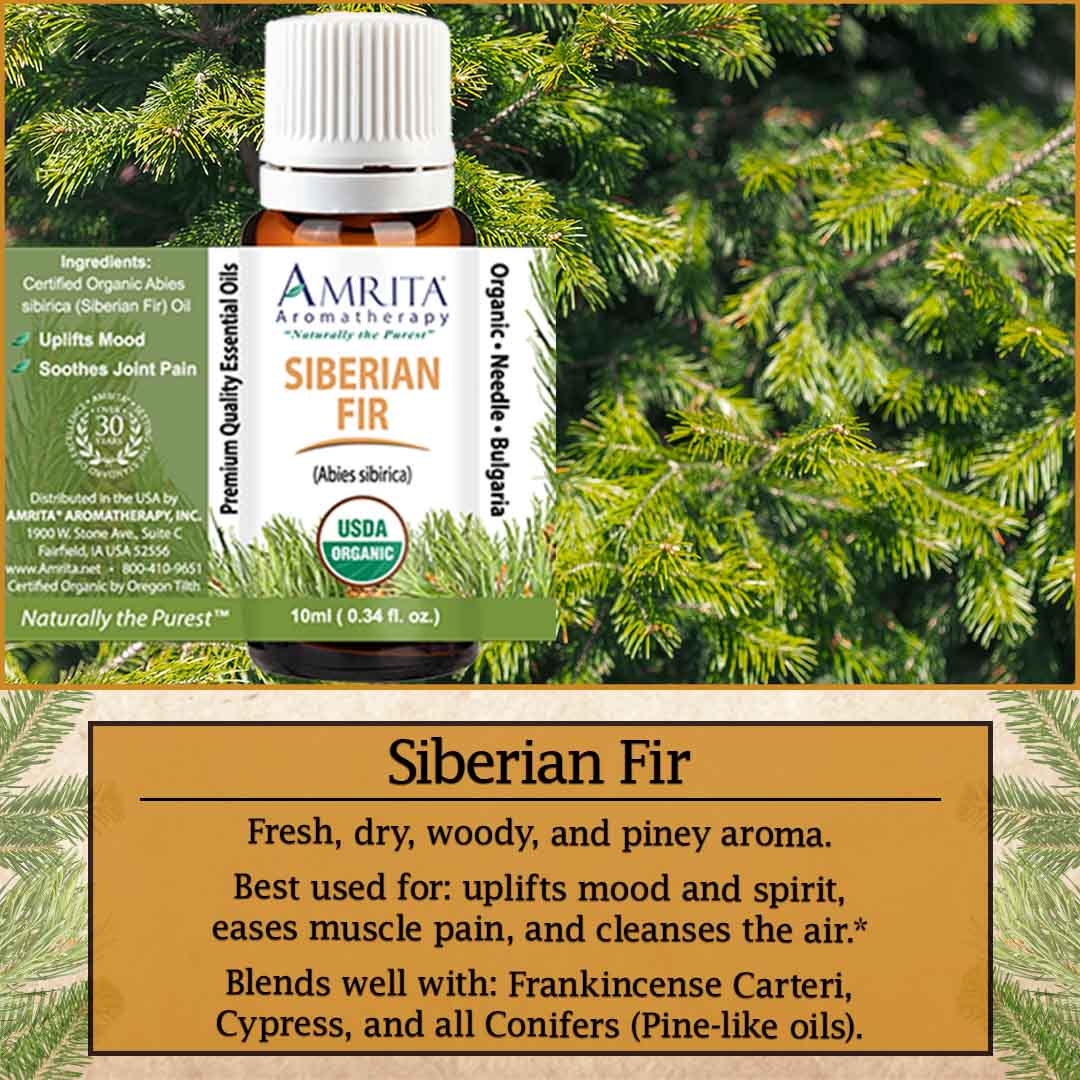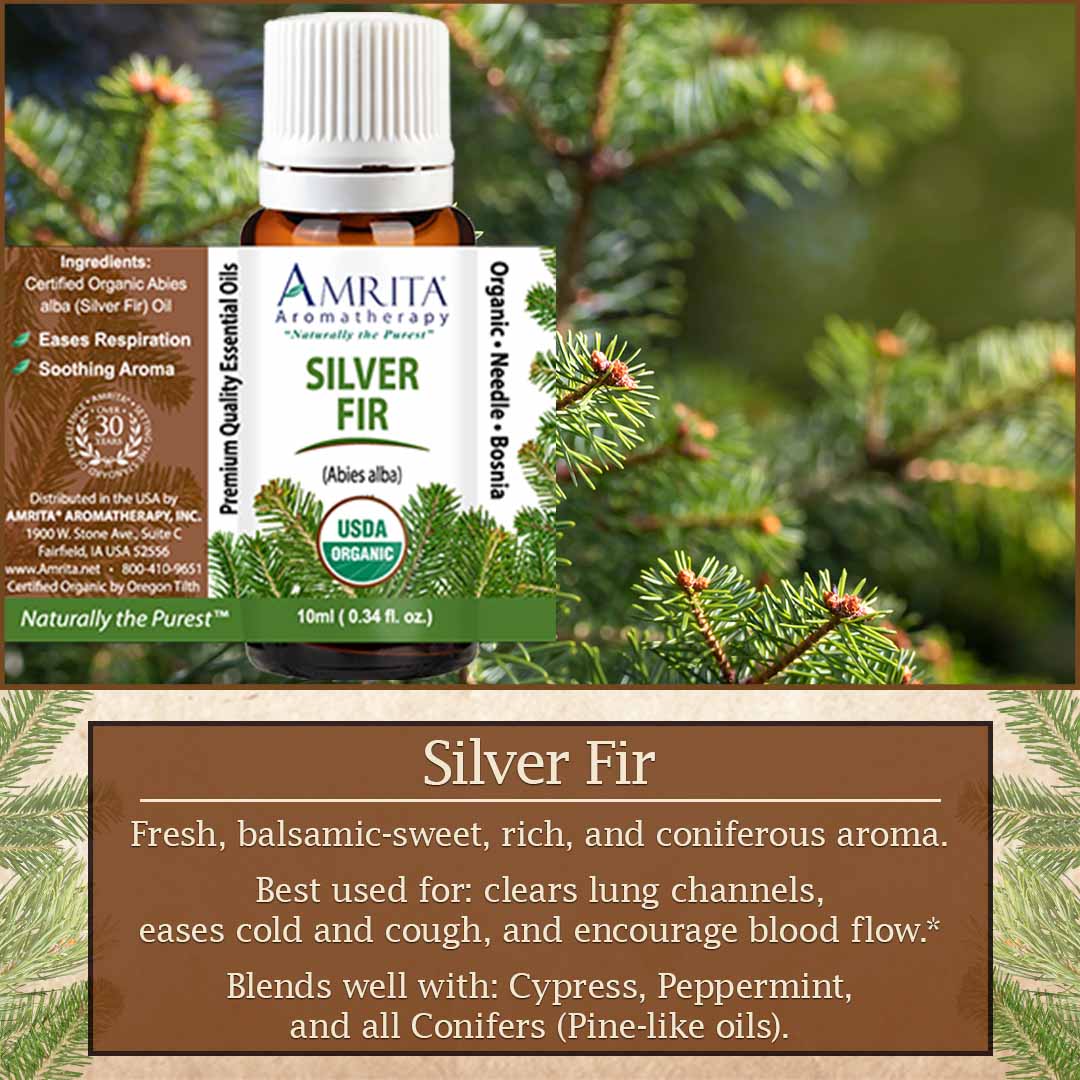This or That: Balsam, Siberian, or Silver Fir
Jun 13th 2024
Posted by Dr. Christoph Streicher and Chase F.
In the vast world of essential oils, few offerings hold the same captivating allure and therapeutic potency as Fir oils. Today, we embark on a journey through forests and mountains to unravel the distinctive characteristics and therapeutic benefits of three essential oils derived from different subspecies of fir trees: Balsam Fir, Siberian Fir, and Silver Fir. Beyond their aromatic profiles and chemical compositions, each has a distinctive personality of its own.
There are three subspecies of Fir Essential Oils offered by Amrita Aromatherapy, each with its own olfactory profile and geographic origin. Balsam Fir (Abies balsamea) hails from North America and is known for its fresh, piney, and invigorating aroma. Siberian Fir (Abies sibirica) originated in the frosty realms of Eastern Europe and offers a mellower, woodier, and more soothing aromatic essence. Finally, as we swing back towards western Europe, there is Silver Fir (Abies alba). Known by some as “true” fir, it exudes the rich, forest-like, balanced, and crisp aroma of an alpine forest that energizes the spirit.*
While there are many therapeutic similarities among the members of this botanical family, a few subtle differences exist that are worth mentioning. So, without further ado, here is a short breakdown of three distinct Fir Essential Oils.
Balsam Fir (Abies balsamea)
The Balsam Fir tree holds a significant place in the cultural tapestry of North America. Indigenous peoples, including the Algonquin, Ojibwe, and Cree, revered the Balsam Fir for its medicinal properties and used various parts of the tree in their healing rituals. The tree’s resin was traditionally applied to wounds for its antiseptic properties, while its needles were brewed into teas to alleviate respiratory ailments.* European settlers also recognized the therapeutic value of Balsam Fir, leading to its inclusion in early American pharmacopoeias. Its resin, known as “Canada Balsam,” gained renown as a natural adhesive and was used in the manufacture of optical instruments as a sealing agent.
Today, Balsam Fir Essential Oil continues to captivate aromatherapy enthusiasts and holistic practitioners alike. Its invigorating scent is renowned for its ability to energize and uplift the spirit even as it helps to quell stress and anxiety, making it a popular choice for diffusing in gyms, workplaces, and wellness spaces.* While many practitioners employ breathing exercises or meditation to cultivate prana and regulate breath, the inclusion of Balsam Fir can further aid in regulating and enhancing prana flow.* In massage blends, Balsam Fir is additionally valued for its soothing effects on tired muscles and its potential to ease discomfort associated with arthritis and rheumatism.*
Such therapeutic properties can be attributed to its rich chemical composition, which includes constituents like α-Pinene, β-Pinene, Camphene, and Limonene. α-Pinene, in particular, exhibits antimicrobial and anti-inflammatory properties while Limonene and Camphene contribute to the oil’s uplifting aroma and invigorating qualities.* These compounds work synergistically to provide a range of therapeutic benefits, from respiratory support to stress relief.*
Methods of Application for Balsam Fir:
- Topical Application: A 3-5% dilution of Balsam Fir Essential Oil can be mixed with Jojoba or Hazelnut Carrier Oil and applied topically to areas affected by headaches, migraines, muscle soreness, or joint pain.* Topical application to minor skin wounds can help to clean and soothe them while encouraging quick healing.* Dilutions of 3% or less can be used in massage blends or bath mixes to encourage relaxation of the body while fortifying the mind and spirit.* Apply a small portion of this blend, not to exceed 10 drops per application per day.*
- Diffusion / Inhalation Application: A few drops of Balsam Fir Essential Oil can be added to a nebulizer or inhaler to address respiratory issues such as congestion or cough, as well as to promote a sense of confidence and well-being.* Its aroma is moderately sharp, described as clean, invigorating, crisp, and coniferous.
If you would like to read more, visit Balsam Fir Essential Oil.
Siberian Fir (Abies sibirica)
Siberian Fir has been cherished for its soothing aroma and versatile applications for millennia. Long revered in the rugged landscapes of Siberia and Northern Asia, Indigenous peoples of regions including Khanty, Evenki, and Yakut held this subspecies of Fir in high esteem for its resilience and survival in harsh climates. The tree’s branches were used in traditional ceremonies and rituals to evoke protection and strength, while its resin was prized for many medicinal and practical purposes.
Today, Siberian Fir Essential Oil holds a well-established notoriety within the aromatherapy industry with its aromatic and therapeutic qualities, as well as its accessibility. Its fresh, woody aroma is renowned for the ability to promote relaxation and mental clarity, making it a popular choice for diffusing in homes and meditation spaces.* In topical applications, Siberian Fir Essential Oil is valued for its soothing effects on sore muscles and joints, as well as its potential to alleviate symptoms of respiratory congestion and stress.*
While the chemical composition of Siberian Fir Essential Oil exhibits many similarities to other members of the Fir family, it is a favorite of many due to its relatively low levels of monoterpenes. This makes for a significantly more mellow aromatic profile, and a much less stimulating effect on the mind and body, making it a smart choice for younger, or more sensitive users.* Another added bonus of Siberian Fir is its abundance of availability, often one of the most affordably priced options among its peers.
Methods of Application for Siberian Fir:
- Topical Application: A 2-5% dilution of Siberian Fir Essential Oil can be mixed with Jojoba or Hazelnut Carrier Oil and applied topically to address respiratory congestion or areas of muscle/joint discomfort.* For body care, it can help to facilitate the healing of wounds while safely cleaning and soothing them.* Dilutions of 2% or less can be used in massage blends or bath mixes to relax the body and to promote a sense of calm, relaxation, and clarity.* Apply a small portion of this blend, not to exceed 10 drops per application per day.*
- Diffusion / Inhalation Application: A few drops of Siberian Fir Essential Oil can be added to a nebulizer or inhaler to address respiratory issues such as congestion or cough, as well as to promote a sense of calm and relaxation.* Its aroma is mellower than other members of the Fir family, described as dry, woody, and soothing.*
If you would like to read more, visit Siberian Fir Essential Oil.
Silver Fir (Abies alba)
Silver Fir boasts a rich history within European herbalism and has been long associated with strength, resilience, and divine qualities.* In Celtic mythology, the Silver Fir was considered a symbol of wisdom and protection, while in Germanic folklore it was believed to possess magical powers that could ward off evil spirits.* Traditionally, its resin was treasured for its abilities to tackle respiratory ailments, reduce fevers, and to support healthy immune function.* Silver Fir was famously applied to many wounds during the American Civil due to its antiseptic and analgesic properties.*
Today, Silver Fir Essential Oil holds a vital place within aromatherapy, touting a myriad of therapeutic benefits. Its rich, balanced, balsamic-sweet, coniferous aroma is treasured for the ability to promote mental clarity and uplift the spirit, making it a great choice for diffusing in workplaces and other places of activity.* In massage blends, Silver Fir is valued for its soothing effects on sore muscles and joints, as well as its potential to alleviate symptoms of respiratory ailments, stress, and anxiety.* It is also known for its rubefacient action, meaning it can promote healthy blood to the skin and throughout the body.* This can help heal wounds more quickly, as well as benefit virtually every vital system in the body, including the immune system.*
Silver Fir Essential Oil consists of a thorough list of naturally beneficial compounds including α-Pinene, β-Pinene, Limonene, Bornyl Acetate, Phellandrene, Camphene, and Carene. This is why it’s considered by some to be an ideal balance between its other family members, Siberian Fir and Balsam Fir. Less stimulating than Balsam Fir but more so than Siberian Fir, Silver Fir Essential Oil is perhaps the most versatile of the three.* The aroma of Silver Fir is another indicator of this, as its complex profile seems more representative of an entire forest, as opposed to just one specific type of conifer tree. In terms of cost, Silver Fir tends to be the most expensive of the fir oils, but still falls within a relatively reasonable price range due to its worldwide abundance.
Methods of Application for Silver Fir:
- Topical Application: A 3-5% dilution of Silver Fir Essential Oil can be mixed with Jojoba or Hazelnut Carrier Oil and applied topically to address respiratory congestion or areas of muscle/joint discomfort.* For the skin, topical application can help wounds heal more quickly and stimulate blood flow, resulting in a rosy, healthy complexion.* Dilutions of 2% or less can be used in massage blends or bath mixes to relax the body and promote a sense of calm and clarity in the mind, body, and soul.* Apply a small portion of this blend, not to exceed 10 drops per application per day.*
- Diffusion / Inhalation Application: A few drops of Silver Fir Essential Oil can be added to a nebulizer or inhaler to address respiratory issues such as congestion or cough, as well as to soothe headaches or migraines.* The rich, sweet, piney, forest-like aroma can help provide users with feelings of confidence, energy, and clarity.*
If you would like to read more, visit Silver Fir Essential Oil.
Safety Concerns and Precautions
When using Fir essential oils, it is always important to do so safely and responsibly. Always dilute essential oils according to Amrita’s instruction before applying to the skin, perform a patch test before applying to broader areas in order to insure there is no sensitivity, discontinue if irritation occurs, and keep essential oils out of reach of children and pets.* Fir essential oils are generally not recommended for use with small children or women who are breastfeeding.* Any exceptions should be approved by a licensed aromatherapy expert or health professional.
Final Thoughts from the Amrita Team…
Whether you seek the crisp invigoration of Balsam Fir, the gentle tranquility of Siberian Fir, or the balanced versatility of Silver Fir, incorporating these essential oils into your aromatherapy practice can enhance both physical well-being and spiritual connection with nature.* Practically everyone has happened upon some kind of fir tree in the wild and knows firsthand the pleasant effect it can provide for the senses.* This common sensory reaction is simply the brain telling the body that it has encountered something good, pure, and beneficial.*
Therefore, it should come as no surprise that so much research and experimentation has been done with Fir species over the ages, leading to a wealth of knowledge regarding their therapeutic benefits. And after millennia of trial and error, it has been quite literally boiled down to a science. Amrita Aromatherapy (an industry leader since 1989) offers the purest available sources of Balsam Fir, Siberian Fir, and Silver Fir Essential Oils, chemically analyzed and scientifically documented. After reading about the differences between these three subspecies of Fir, as well as their similarities, let this newly found knowledge be your guide for trying one or all of them today!
*These statements have not been evaluated by the Food and Drug Administration. These products are not intended to diagnose, treat, cure, or prevent any disease.




